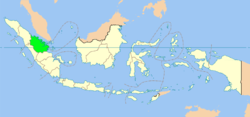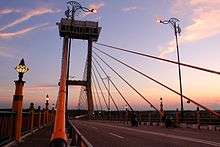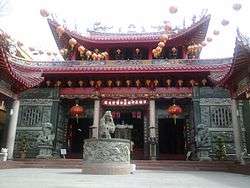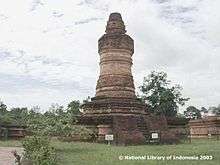Riau
| Riau Riau | |||||||||
|---|---|---|---|---|---|---|---|---|---|
| Province | |||||||||
| Other transcription(s) | |||||||||
| • Jawi | رياو | ||||||||
| • Chinese | 廖内 | ||||||||
From top, left to right: Siak Palace, Tengku Agung Sultanah Latifah bridge, An-Nur Mosque, Tesso Nilo National Park, Hoo Ann Kiong Temple in Selatpanjang, Riau Main Stadium a largest stadium in Riau and Muara Takus Temple | |||||||||
| |||||||||
|
Motto: Bumi Bertuah Negeri Beradat (Malay) (Ground of Fortunes, Land of Customs) | |||||||||
 Location of Riau in Indonesia | |||||||||
| Coordinates: 0°32′N 101°27′E / 0.533°N 101.450°ECoordinates: 0°32′N 101°27′E / 0.533°N 101.450°E | |||||||||
| Country |
| ||||||||
| Established | August 10, 1957 | ||||||||
| Capital |
| ||||||||
| Government | |||||||||
| • Body | Riau Regional Government | ||||||||
| • Governor | Arsyadjuliandi Rachman (Golkar) | ||||||||
| • Vice-governor | Vacant | ||||||||
| Area | |||||||||
| • Total | 87,023.66 km2 (33,600.02 sq mi) | ||||||||
| Area rank | 7th | ||||||||
| Elevation | 10 m (30 ft) | ||||||||
| Highest elevation | 1,091 m (3,579 ft) | ||||||||
| Lowest elevation | 0 m (0 ft) | ||||||||
| Population (2015)[1] | |||||||||
| • Total | 6,344,402 | ||||||||
| • Rank | 10th | ||||||||
| • Density | 73/km2 (190/sq mi) | ||||||||
| • Density rank | 24th | ||||||||
| Demonym(s) |
Riauan Warga Riau (id) Kaum Riau (ms) | ||||||||
| Demographics | |||||||||
| • Ethnic groups | Malay (33.28%), Javanese (29.20%), Batak (12.55%), Minangkabau (12.29%), Banjar (4.13%)[2] | ||||||||
| • Religion | Islam (89.27%), Protestantism (7.87%), Buddhism (1.84%), Roman Catholicism (1.06%), Confucianism (0.08%), Hinduism (0.07%) | ||||||||
| • Languages |
Indonesian (official) Malay, Minangkabau, Hokkien (regional) | ||||||||
| Time zone | Indonesia Western Time (UTC+7) | ||||||||
| Postcodes | 28xxx, 29xxx | ||||||||
| Area codes | (62)6xx, (62)76x | ||||||||
| ISO 3166 code | ID-RI | ||||||||
| Vehicle sign | BM | ||||||||
| GRP per capita | US$ 9,252.17 | ||||||||
| GRP rank | 3rd | ||||||||
| HDI |
| ||||||||
| HDI rank | 6th (2015) | ||||||||
| Largest city by area | Dumai - 1,623.38 square kilometres (626.79 sq mi) | ||||||||
| Largest city by population | Pekanbaru - (929,247 - 2015) | ||||||||
| Largest regency by area | Indragiri Hilir Regency - 11,605.97 square kilometres (4,481.09 sq mi) | ||||||||
| Largest regency by population | Kampar Regency - (711,236 - 2015) | ||||||||
| Website | Government official site | ||||||||
Riau (Jawi: رياو, Chinese: 廖内; pinyin: Liào nèi) is a province of Indonesia. It is located in the central eastern coast of Sumatra along the Strait of Malacca. Until 2004 the province included the offshore Riau Islands, a large group of small islands (of which the principal islands are Batam and Bintan) located east of Sumatra Island and south of Singapore, before these islands were split off as Riau Islands Province in July 2004. The provincial capital of Riau Province and its largest city is Pekanbaru. Other major cities include Dumai, Selat Panjang, Bagansiapiapi, Bengkalis, Bangkinang, Rengat and Siak Sri Indrapura. The province shares land borders with North Sumatra to the northwest, West Sumatra to the west, and Jambi to the south.
The total area for Riau province is 87,023.66 km² , which stretches from the slopes of the Bukit Barisan to the Strait of Malacca. Riau has a wet tropical climate with average rainfall ranging between 2000-3000 millimeters per year, and the average rainfall per year is about 160 days.
Riau is currently one of the richest provinces in Indonesia and is rich in natural resources, particularly petroleum, natural gas, rubber, palm oil and fibre plantations. Extensive logging and plantation development in has led to a massive decline in forest cover Riau, and associated fires have contributed to haze across the larger region.
Since the 1970s, much of Indonesia has experienced a decline in population growth rates. Riau has been a significant exception, with increasing rates every decade since 1970 to a 4.35 percent annual rise for the 1990s;[3] however, this rate slowed significantly during the subsequent decade. The provincial population was 5,538,367 at the 2010 census.[4] and according to the estimate for January 2014 this had risen to 6,358,636.
Etymology
Several theories exist for the origin of the word Riau province.
Three theories exist for the origin of Riau's name. One suggests that it is a mutation of the Portuguese name "Rio River", referring to a local river. A Portuguese military expedition explored the Siak river in 1514, searching for a kingdom believed to exist in the region, as well as pursuing followers of Sultan Mahmud Shah who tried to escape income taxes following the fall of the Malacca Sultanate.
A second theory suggests that Riau is a mutation of the local word riahi, meaning "sea air".
A third theory says that the province was named after a singer popular in local communities, who was described as rioh ("boisterous").
A fourth theory instead asserts that rioh was a description of locals by settlers from Johor led by Raja Kecik in 1719.
History
Dutch colonial period
The local Siak people could not resist the aggressive Dutch invasion. The Dutch narrowed the sovereign territory of the Siak by establishing a residency in Riau (Residentie Riow) at Tanjung Pinang, under the rule of the Dutch East Indies. The residents were to monitor the coastal areas of Sumatra. The Sultan of Siak, tied to an agreement with the Netherlands, could not intervene. Siak influence was further weakened by tensions between the Netherlands and the United Kingdom (the latter dominating the Straits of Malacca) at strategic areas on the east coast of Sumatra. The Sultan of Siak was forced to surrender Siak territory to the Netherlands in an agreement in July 1873, where power was handed to the Dutch Bengkalis. At the same time period, Indragiri began to be influenced by the Dutch (although the latter only managed to control Batavia in 1938), and Dutch dominance of the Siak was a factor of the outbreak of war in Aceh. The Netherlands also quickly abolished smaller kingdoms on the coast that were not subjects. On the coast, the Netherlands moved quickly abolished the kingdoms that still have not been subject. Finally, the Netherlands managed to impeach Sultan of Riau-Lingga, Sultan Abdul Rahman Muazzam Shah in February 1911.
Japanese occupation
Riau became a prime target for occupation during the Japanese invasion. Rengat was occupied on March 31, 1942. The rest of Riau was then swiftly subjugated under Japanese rule.
Legacy of the Japanese occupation include a now abandoned 300km railway line connecting Muaro Sijunjung and Pekanbaru, completed through forced labor by hundreds of thousands of Riau locals.
Post-war
Riau Province was formerly part of the Central Sumatra Province, but the rebellion of Dewan Banteng saw Riau being occupied on 1 January 1957. On 9 August 1957, then president Soekarno declared an independent Riau Province.
In 1999, the second son of the first Djasit Riau took up his parent's post and served as governor in the Provincial Parliament. He was succeeded by former Regent of Indragiri Hilir, Rusli Zainal, who was elected in 2004 and 2008, and then succeeded by Annas Mahmun. Both Rusli Zainal and Annas Mahmun were removed from post and jailed following corruption scandals. Arsyadjuliandi Rachman, nicknamed "Andi", is the current governor of Riau.[5]
Riau is under review by the Indonesian government for reorganisation.
Demographics
The population of the province of Riau based on data from the Central Statistics Agency of Riau Province in 2010 amounted to 5,543,031 inhabitants. Regency / City which has the largest population is Pekanbaru city with a population of 903 902 inhabitants, while the district / city with the smallest population of Kepulauan Meranti, amounting to 176 371 inhabitants.
Ethnic groups
Riau provincial population consists of diverse ethnic groups. They consist of Java (25.05%), Minangkabau (11.26%), Batak (7.31%), Banjar (3.78%), Chinese (3.72%), and Bugis (2.27% ). The Malays are the largest community with a composition of 37.74% of the entire population of Riau. They generally come from coastal areas in Rokan Hilir, Dumai, Bengkalis, Meranti Islands, up to Pelalawan, Siak, Inderagiri Inderagiri Upstream and Downstream. However, there are also indigenous Minangkabau ethnic clumps mainly from areas Rokan Hulu, Kampar, Kuantan Singingi, and partly Inderagiri Hulu. Also Mandailing community in Rokan Hulu, which is claimed to be a Malay rather than as Minangkabau or Batak. The 19th century, the people of South Kalimantan Banjar and Bugis from South Sulawesi, also began arriving in Riau. They are widely settled in Indragiri Hilirkhususnya Tembilahan. The opening of Caltex oil mining company in the 1940s in Rumbai, encouraging people from throughout the country to try his luck in Riau. Javanese and Sundanese in general, many migrants are in the area. While ethnic Minangkabau generally become merchants and many living in urban areas such as Pekanbaru, Bangkinang, Duri, and Dumai. Likewise, Chinese people are generally the same as the ethnic Minangkabau are becoming merchants and settled especially in Pekanbaru, and many are also found in coastal areas in the east as Bagansiapiapi, Selatpanjang, Rupat and Bengkalis. Other than that in the province, there are a set of indigenous people who live in rural areas and riverbanks, such as Sakai tribe, Akit Tribe, Talang Mamak and Orang Laut.
Religion
Education
Riau has several universities, including the University of Riau, Riau Islamic University, University of Muhammadiyah Riau Islamic University of Sultan Syarif Kasim Riau, Lancang Kuning University, University Abdurrab, University Sand Pengaraian, Universitas Islam Indragiri, Islamic University Kuantan Singingi, Polytechnic of Bengkalis and Politeknik Caltex Riau.
Economy
The economy of Riau expands faster (8.66% in 2006) than the Indonesian average (6.04% in 2006), and is largely a resource-based economy, including crude oil (600,000 bpd), palm oil, rubber trees and other forest products. Local government income benefits from a greater share of tax revenue (mainly from crude oil) due to the decentralisation law of 2004.[7]
The province has natural resources, both riches contained in the bowels of the earth, in the form of oil and gas, as well as gold, as well as forest products and plantations. Along with the implementation of regional autonomy, gradually began to apply the system for results or financial balance between central and local. The new rules provide expressly limits the obligations of investors, resource utilization, and revenue-sharing with the surrounding environment.
Agriculture and Plantation
Plantation growing is rubber and oil palm plantations, either run by the state or by the people. There is also a citrus and coconut plantations. For oil palm plantation area currently Riau province has a land area of 1:34 million hectares. In addition there have been about 116 palm oil mills (PKS) which operates with the production of coconut palm oil (CPO) 3.3868 million tons per year.
Forests and Fishery
Deforestation (in Indragiri Hulu); Forestry development essentially includes all efforts to utilize and strengthen the natural resource functions of forests and other natural resources and the ecosystem, both as a patron and life support and preservation of biodiversity as well as resource development. But in reality had lost its three primary functions, namely the function of long-term economic, protection function, and aesthetics as the impact of government policies ago. The loss of the three functions above led to an increased extent of critical lands caused by forest products companies that ignore the aspect of sustainability. The next effect is the decreasing production of non timber forest concessions, while reforestation and afforestation efforts have not been optimally implemented. Another issue that is detrimental not only to the province of Riau in particular but Indonesia in general, is the problem of illegal logging leading to reduced forest areas and the problem of illegal sand dredging.
Industry
In this province there are several international companies engaged in the oil and gas as well as the processing of forest products and oil. In addition there is also a copra and rubber processing industry. Several major companies including Chevron Pacific Indonesia a subsidiary of Chevron Corporation, PT. Indah Kiat Pulp & Paper Tbk in Perawang, and PT. Riau Andalan Pulp & Paper in Pangkalan Kerinci Riau provincial mining Mining Results are Petroleum, Gas, and Coal.
Transportation
Highway linking the West Sumatra and Riau in Kampar regency of Riau province is the only province that has enterprises in the field of air transport, namely PT. Riau Air, which aims to serve areas that are difficult to reach by road or sea. Riau Air operates the Dutch-made Fokker-50 fleet of five, and in 2008 the company added two more fleet with the type Avro RJ-100.
Finance and Banking
In the field of banking in the province is growing rapidly, this marked the number of private banks and rural banks, in addition to local government-owned banks such as Bank Riau Kepri
Language
Riau Province is home to various dialects of the Malay and Chinese language. The dominant language used by the Malay population is Malay. The Chinese population (predominantly Hokkien) speak a variety of Chinese dialects, the most common being Min Nan, originating from the southern part of Fujian province in the south-eastern part of China. Present-day inhabitants are migrants from other provinces, speaking a variety of languages, mostly Minangkabau as well as Javanese.
Riau Malay
The dialect of Malay spoken in Riau Province is considered by linguists to have one of the least complex grammars among the languages of the world, apart from creoles, possessing neither noun declensions, temporal distinctions, subject/object distinctions, nor singular/plural distinction. For example, the phrase Ayam makan (lit. 'chicken eat') can mean, in context, anything from 'the chicken is eating', to 'I ate some chicken', 'the chicken that is eating' and 'when we were eating chicken'. A possible reason for this is that Riau Malay has been used as a lingua franca for communication between different people in this area during its history, and extensive foreign-language speaker use of this kind tends to simplify the grammar of a language used.[8] The traditional script in Riau is Jawi (locally known in Indonesia as "Arab-Melayu"), an Arabic-based writing in the Malay language.[9]
It is sometimes supposed that Riau Malay is the basis for the modern national language, Indonesian. However, it is instead based on Classical Malay, the court language of Johor-Riau Sultanate, based primarily from the one used in the Riau archipelago and the state of Johor, Malaysia, which is distinct from the local mainland Riau dialect.[10]
Non-mainstream varieties in Riau include Orang Sakai, Orang Asli, Orang Akit, and Orang Laut.[11]
Riau Minangkabau
Minangkabau language is the indigenous language of the western part of Riau, mainly in the Pekanbaru, Kampar, Kuantan, and Rokan Hulu.[12] The pronunciation of Riau Minangkabau similar to Payakumbuh-Batusangkar dialect, even differs from that of other dialects varieties of West Sumatra. Historically, Minangkabau language used in the Sultanate of Siak and nowadays also spoken in the lower Siak river basin.
Administrative divisions
| Historical population | ||
|---|---|---|
| Year | Pop. | ±% |
| 1971 | 1,641,545 | — |
| 1980 | 2,168,535 | +32.1% |
| 1990 | 3,303,976 | +52.4% |
| 1995 | 3,900,534 | +18.1% |
| 2000 | 4,957,627 | +27.1% |
| 2010 | 5,538,367 | +11.7% |
| 2014 | 6,358,636 | +14.8% |
| sources:[13][14] Note: Census years not equidistant, 2010 excludes Riau Islands split. | ||
Riau Province is subdivided into ten regencies (kabupaten) and two autonomous cities (kota), listed below with their areas and their populations at the 2010 Census and according to the latest (January 2014) estimates.
| Name | Area (km2) | Population Census 2010 | Population Estimate 2014 | Capital | HDI [15] 2014 Estimates |
|---|---|---|---|---|---|
| Dumai City | 1,623.38 | 253,803 | 291,393 | Dumai | 0.718 (High) |
| Pekanbaru City | 632.27 | 897,767 | 1,030,732 | Pekanbaru | 0.784 (High) |
| Bengkalis Regency | 6,976.41 | 498,336 | 572,143 | Bengkalis | 0.708 (High) |
| Indragiri Hulu Regency | 7,723.80 | 363,442 | 417,270 | Rengat | 0.671 (Medium) |
| Indragiri Hilir Regency | 12,614.78 | 661,779 | 759,793 | Tembilahan | 0.638 (Medium) |
| Kampar Regency | 10,983.47 | 688,204 | 790,132 | Bangkinang | 0.707 (High) |
| Kepulauan Meranti Regency (Meranti Islands) | 3,707.84 | 176,290 | 202,400 | Selat Panjang | 0.629 (Medium) |
| Kuantan Singingi Regency | 5,259.36 | 292,116 | 335,380 | Teluk Kuantan | 0.674 (Medium) |
| Pelalawan Regency | 12,758.45 | 301,829 | 346,532 | Pangkalan Kerinci | 0.686 (Medium) |
| Rokan Hulu Regency | 7,588.13 | 474,843 | 545,170 | Pasir Pangaraian | 0.670 (Medium) |
| Rokan Hilir Regency | 8,851.59 | 553,216 | 635,151 | Bagansiapiapi | 0.662 (Medium) |
| Siak Regency | 8,275.18 | 376,742 | 432,540 | Siak Sri Indrapura | 0.714 (High) |
Ecology
Forest cover in Riau has declined from 78% in 1982 to only 33% in 2005.[16] This has been further reduced an average of 160,000 hectares on average per year, leaving 22%, or 2.45 million hectares left as of 2009.[17] Fires associated with deforestation have contributed to serious haze over the province and cities to the East, such as Singapore and Kuala Lumpur, Malaysia [18][19] .

Giam Siak Kecil – Bukit Batu Biosphere Reserve, Indonesia, is a peatland area in Sumatra featuring sustainable timber production and two wildlife reserves, which are home to the Sumatran tiger, Sumatran elephant, Malayan tapir, and Malayan sun bear. Research activities in the biosphere include the monitoring of flagship species and in-depth study on peatland ecology. Initial studies indicate a real potential for sustainable economic development using native flora and fauna for the economic benefit of local inhabitants.
Cagar Biosfer Giam Siak Kecil Bukit Batu (CB-GSK-BB) is one of seven Biosphere Reserves in Indonesia. They are located in two areas of Riau Province, Bengkalis and Siak. CB-GSK-BB is a trial presented by Riau at the 21st Session of the International Coordinating Council of Man and the Biosphere (UNESCO) in Jeju, South Korea, on 26 May 2009. CB-GSK-BB is one of 22 proposed locations in 17 countries accepted as reserves for the year. A Biosphere Reserve is the only internationally recognised concept of environmental conservation and cultivation. Thus the supervision and development of CB-GSK-BB is a worldwide concern at a regional level.
CB-GSK-BB is a unique type of Peat Swamp Forest in the Kampar Peninsula Peat Forest (with a small area of swamp). Another peculiarity is that the CB-GSK-BB was initiated by private parties in co-operation with the government through BBKSDA (The Center for the Conservation of Natural Resources), including the notorious conglomerate involved in forest destruction, Sinar Mas Group, owning the largest paper and pulp company in Indonesia.
Sports
Riau has a football team, PSPS Pekanbaru, based in Kaharuddin Nasution Stadium, Pekanbaru. There is football team PS Siak too. In 2012, Riau hosted Pekan Olahraga Nasional.
See also
References
- ↑ "Provinsi Riau Dalam Angka 2016" (PDF) (in Indonesian). Retrieved 2016-09-22.
- ↑ Aris Ananta; Evi Nurvidya Arifin; M. Sairi Hasbullah; Nur Budi Handayani; Agus Pramono (2015). Demography of Indonesia’s Ethnicity. Institute of Southeast Asian Studies dan BPS – Statistics Indonesia.
- ↑ BPS:Laju Pertumbuhan Penduduk menurut Provinsi
- ↑ Central Bureau of Statistics: Census 2010, retrieved 17 January 2011 (in Indonesian)
- ↑ "Daftar Gubernur Riau". Wikipedia bahasa Indonesia, ensiklopedia bebas (in Indonesian). 2017-04-03.
- ↑ "Population by Region and Religion in Indonesia". BPS. 2010.
- ↑ Riau, Provinsi yang Maju Pesat
- ↑ McWhorter, John (2001). "The world's simplest grammars are creole grammars". Linguistic Typology. Walter de Gruyter. 5 (2001): 125–166. doi:10.1515/lity.2001.001.
- ↑ Gil, David (2008). Miestamo, Matti; Sinnemäki, Kaius; Karlsson, Fred, eds. How complex are isolating languages?. Language complexity: Typology, contact, change (Studies in Language Companion Series 94). Amsterdam: Benjamins. pp. 109–131.
- ↑ Sneddon 2003, The Indonesian Language: Its History and Role in Modern Society, p. 70
- ↑ "Dept. of Linguistics | Linguistic Field Work in Riau Province, Indonesia". Eva.mpg.de.
- ↑ Bambang Kaswanti Purwo; Kajian Serba Linguistik: untuk Anton Moeliono, Pereksa Bahasa; BPK Gunung Mulia, 2000
- ↑ "Statistics Indonesia". Bps.go.id.
- ↑ http://www.depkes.go.id/downloads/Penduduk%20Kab%20Kota%20Umur%20Tunggal%202014.pdf Estimasi Penduduk Menurut Umur Tunggal Dan Jenis Kelamin 2014 Kementerian Kesehatan
- ↑ Indeks-Pembangunan-Manusia-2014
- ↑ WWF:The Eleventh Hour for Riau's Forests
- ↑ "Logging moratorium 'a must' to save Riau forests". The Jakarta Post. 16 May 2009.
- ↑ "'Indonesian'-made haze covers parts of KL, surrounding areas". The Jakarta Post. 16 June 2012.
- ↑ http://www.bernama.com/bernama/v6/newsindex.php?id=673630
.jpg)








